Historic post.
 Bashny.Net
Bashny.Net
Historic post.

The last major domestic avtodizaynerov luck and time, and the title coincided with the biggest achievement of Russian armed forces.
In the history of domestic car "Victory" it became a symbol of the postwar era - when the country was reborn from the ashes and is committed to new frontiers, surely becoming a superpower. It was a time of great hope and remarkable achievements that are etched in people's minds with the silhouette of the popular car. The concept of development of the automotive industry of the USSR in the 30s was determined not only economic but also political considerations. On the one hand, the emphasis on rapid replenishment fleet of trucks, military vehicles and public transport. Last allows you to quickly solve the problem of traffic is rapidly growing urban populations.
On the other hand, contrary to the well-known adage, cars were for the majority of citizens is not so much a means of transportation as a luxury. Because there were not enough of them and they cost is not cheap, their owners watched with envy. The party leadership has been a view that the private passenger cars - is "regurgitation of the bourgeoisie" and the Soviet people will be enough buses and taxis. Defeating the resistance of conservative Marxists could a simple argument: the mass production of fairly inexpensive car will make it as accessible technical means, as well as home appliances. It is only necessary to create for this industrial base.
This possibility emerged in the late 30s. At the Gorky Automobile Plant started the development of two models of small cars that were to be the basis for the future of the Soviet "people's car". And as the car of the middle class was offered to replace GAZ-M1 ("Emku") to something more contemporary and release tens of thousands each year. Already thinking about where to build new plant as the Great Patriotic War broke out. All resources, of course, were thrown on the defensive - and gas is fully engaged in the production of military trucks, armored cars, light tanks, commander of cars. However, the design of civilian vehicles did not stop even during those difficult years. It was then developed "Victory».
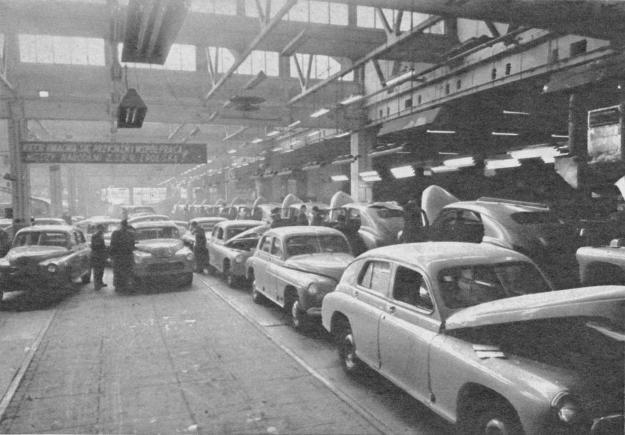
February 3, 1943 the country celebrated the end of the Battle of Stalingrad. In Moscow, opened the meeting Narkomsredmasha dedicated to the creation of the Soviet civilian cars. The decision to renew the old and start new development was met with great enthusiasm, they give people the hope that soon there will come a peaceful life.
However, the summer of 1943, the process was suddenly interrupted: the German long-range aviation began intensive bombing of Soviet enterprises. Heavily damaged and GAZ - according to experts, the restoration required a year, and only thanks to the dedicated work of clock his men failed to start in a month.
The project of the new car of the middle class joined the team under the leadership of Andrew Liphart Automobile (1898-1980). His deputy, Anatoly Krieger (1910-1984) was engaged in chassis and body design and construction - Alexander Kirillov, Yury Sorochkin, as well as the famous painter Benjamin Samoilov.

Initially, the new car was given the working title of the GAZ-25 "Motherland"; and it was the first time that the Soviet passenger car got its own official name. The authors probably thought it would be patriotic. However, they have lost sight of one small detail that, as popular myth, he immediately noticed Joseph Stalin (1878-1953). "Father of nations", he heard the name of the new machine, ironically remarked, and at what price will be sold as "Motherland"? Designers took the hint and immediately changed the name of his brainchild, "christened" his most popular word in 1945 - "Victory". Through subtle sense of humor did not become the leader of the car of the future character of "dissident" jokes, and was named to symbolize the new era of Russian history - which he triumphantly entered gleaming chrome hood.
The car almost from scratch was established during the year - its first model went into the courtyard car plant in November 1944. But at the time of war, even this long, long, because many designers create their models in a few months. Therefore, the fact that in today's automotive industry would be considered a record, then it was the norm. It should take into account the huge resource gap, which is compensated for resourcefulness. For example, wood (alder) details of the layout of the body permanently warped. Then they decided to be made of mahogany, it is unknown where razdobytogo in wartime. But these efforts were justified because it was the body of the main feature of "Victory».
Until that time, all Soviet cars had frame, on which rested the body. In the new project from the frame we have decided to refuse. This was due to the desire to reduce the weight and height of the car to win in speed. However, the first experience of creating a monocoque was unsuccessful, and several hundred "victory" of the first series suffered from the strain and crack the case, they broke down suspension. The errors were taken into account, moreover - to fix them with a solid margin of safety, so that these "Victory" won the reputation of "thick-skinned" domestic cars. That's why many of the "Victory", even after several decades of operation have not rusted to pieces, and in the collisions do not wrinkle as "tin" vases "Muscovites».
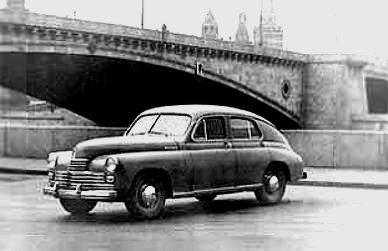
In addition, the design is constantly improved and modernized. It changed the look of the car: two-storey grille in the spring of 1947 gave way to a two-story, in which the lower chrome moldings did not come under the parking lights. Sami parking lights took a simplified form, without expansion in the middle of the round. It appeared on the front bumper beam between the canines. In the housing under the hood - hatch for access to the signals. Implemented Finally, the new solid wheels. An early version of the dashboard, the speedometer with a belt made on the model of the American Chevrolet, has undergone restyling - when you run into a series of simplified design and ennobled. Speedometer decided to establish a familiar, round shape - there was a place for the possible installation of the radio. Headbands headlights chromed steel, which gave clearance completeness front of the machine.
April 28, 1947 showed the Kremlin leaders no longer experienced and serial sample - reported about the start of mass production.
But one thing - Having reported, and the other - to make cars. More or less established cliches, but steelmakers have not been able to supply the required width of the rolled sheet. Yes, and the metal that was available - was beneath criticism. So, in July 1948 metal "Zaporizhstal" for stamping body parts Victory did marriage to 62%! The way out half-measures: at some point, even the metal imported from Belgium, but more often simply taken the appropriate sheets of Zaporozhye rolled, welded them together, and only then sent to the stamping. As it has become a tradition since the pre-production samples to correct surface defects that occur when using such technology to weld seams and dents solder. Though lead-tin solder for one car took 15-20 kg, plus the rest of the deviations from the technology, all this gave weight gain of 200 kg.
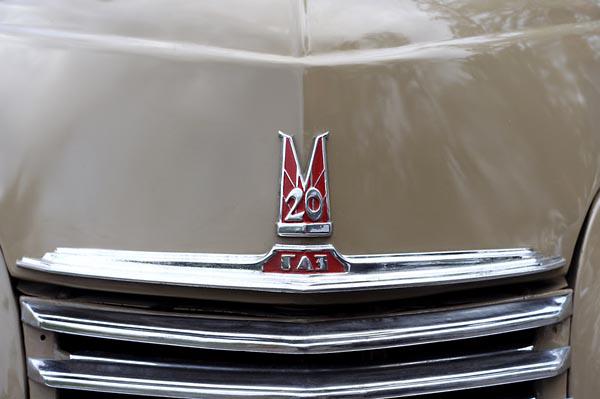
The rush when you run into a series of the best post-war car brought its usual results. Two years later, in October 1948, after the release of 1700 (according to other sources - 600) car, the car at the direction of the main Communist Stalin was discontinued, and all already released Victory (according to some reports) have been returned to the factory for refinement.
The fact that most of the cars produced fell into Soviet institutions to fairly high-ranking officials, who first used the ZIS-101. This category of employees should be provided with class cars ZIS-110, replace the "101st", but producing them is many times smaller than required, therefore a number of "senior officials" had to be transplanted to win. He also did not like the new strongly: crowded, not the speaker, and here and workmanship. In general, the complaints have gone, including the top. All of this boomerang of the plant and the person responsible for the quality, - the chief designer. The situation was paradoxical: the one who opposed the hasty start of the machine in a series, was Lipgart, he did not listen, and then he also had to answer for, against which he fought so fiercely ...
One way or another, but the experience of operation of the first batch of cars has been accounted for, and the plant began to bring the car to the design parameters. It is interesting that during the operation revealed not only weaknesses, but it was noted, and a lot of positive. For example, on any of the machines has never been any case damage the crankcase, despite the fact that the machines operated on rough roads.
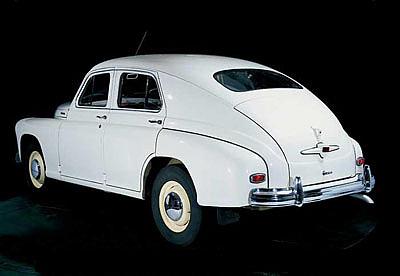
But the flaws were in abundance: the engine detonated, the car is difficult to withstand protracted climbs. Rear Axle noisy. Pothole shook the helm. Door handles were broken. Windscreens burst and glass doors rattled. The interior penetrate dust, rainwater, and the wind was blowing. When starting clutch has constant jerks, revealed the ineffectiveness of the muffler and the parking brake. In addition, quickly boarded the rear suspension, the body turned out to be unequal strength. The car is badly dispersed, I expended a lot of fuel. The paint is quickly lost luster, swells and rebounds. There were no heater and windshield heater, insecure working windows. And the most insulting, especially for officials and military - low ceiling did not allow even a person of average height to sit in a hat or cap, not to mention the monumental hats commanders.
The poor quality of vehicles victory Loskutov released from the post of director of the gas. Waited for the punishment and Liphart. But Andrew A. At the time, escaped with only a reprimand - it took defense minister of the automotive industry Akopov. The fact that the designers of GAZ started work on a new car models GAZ-12, went first manufacturing prototypes GAZ-69, and the experience Liphart here was sorely needed.
Once on the winning effort body, introduced for the rear springs sheets parabolic cross-section, improved muffler, used heater and sealing body, upgraded carburetor, increased to 4, 7 to 5, 125 axle ratio and changed the gear ratios in the box "for children disease "largely outdated.
And at the request of carriers hats removed and tormenting their problem: just cut the plump seat cushion 5 cm in height. Yes, because in the end and left on the entire pipeline - here and material savings, and tall people well.
As a result of this work has been refined and put into production of 346 parts, introduced more than 2,000 new instruments. Is focusing on high-performance equipment and tooling, allow to adjust flow-mass production cars. All technical documentation to clarify and re-released. Redesigned stamps, minimizing the interface in the assembly body stampings. And this is a lot of work, because of all for making the Victory applied 199,457 stamps, tools and instruments!
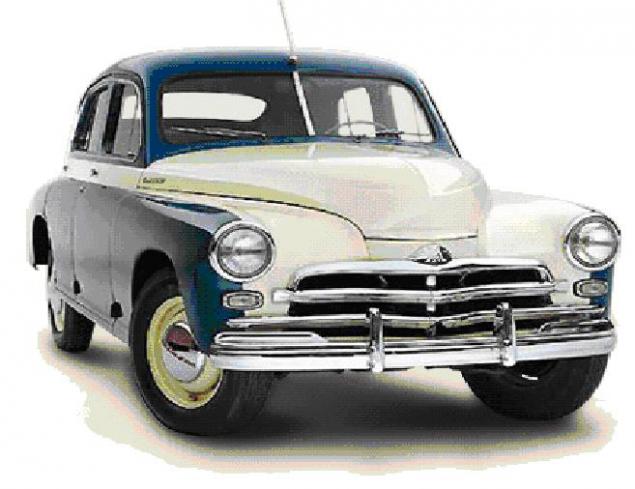
The whole body "Victory" represented an improved version of the type «fastback», which in the 30's - early 40's have used German and Italian avtodizaynery. But he was executed in a smooth, rounded and streamlined lines, and its hood was not archaic "appendix" as its western counterparts. His second feature lies precisely in the fact that "victory" was the world's first passenger car without running boards and protruding wings. The fact that the West has become the norms of automotive design in the 50s and is still practiced in the Soviet Union did in 1943. That is why the "Victory" say that it is the only domestic car that has not been "pinched" with foreign models. On the contrary, the West copied the design of the "Victory", as, for example, the body of a British car «Standard Vanguard» 1947 looks very similar to the GAZ-M-20.
In the Soviet automotive form of "Victory" is no longer repeated, so it remains unique. On issued then ZIS-110 and GAZ-12 ZIM has not been such smooth lines, aerodynamic spoiled serving rudimentnymi and aft wings. The "Victory" is the luggage compartment, are made for the spare wheel, managed to squeeze so as not to disturb the smooth bevel, passing aft roof.
From predecessors "Victory" and featured a great many electrical appliances and machinery, previously unseen in civilian cars. Thus, the body appeared electrolamp direction indicators and brake lights that allow drivers no longer pop out of windows waving hands. Wiper blades on the front glasses got electric running even with the engine off. And inside the oven has been installed, make a winter trip a pleasure, not a test of the body's resistance to frost.
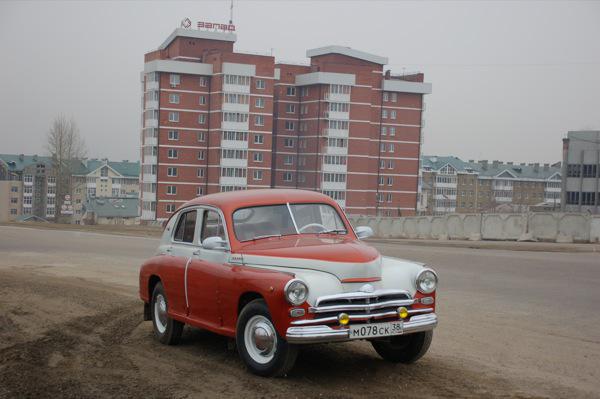
For the new car of the middle class and the corresponding required engine. In "Victory" First set the six-cylinder engine GAZ-11, well mastered the Gorky Automobile Plant during the war - he was mounted on armored vehicles and commanding GAZ-11-73 (a more powerful version of "Emka"). Powerful enough (76 hp with the ability to boost) and reliable, GAZ-11, then worked under the hoods of trucks GAZ-51, GAZ-12 Limousine ZIM, PAZ, and produced until 1992. With him "Victory" have long been the most Soviet fleet cars, but ... six-cylinder engine "hacked" Comrade Stalin personally, which is traditionally the bride brought new models. Not out of spite, but for reasons of economy. In the context of post-war devastation gasoline was expensive. Therefore, Stalin approved the project "Victory" with a less voracious four-cylinder engine producing 52 horsepower, which was used for another GAZ-A. Later, he was released a small batch of six-cylinder "victory" for the KGB garage (model GAZ-20-D), as well as sports modification accelerates to 190 km / h.

August 26th, 1945 in the decree of the State Defense Committee, "On the reconstruction and development of the automotive industry" was, among other things, recommended to start production of a new car of the middle class in the summer of 1946. Having received the serial GAZ M-20 "Victory" started off the assembly line.
But haste has led to numerous defects. And as among the first owners of "Victory" were generals and party officials, their complaints quickly reach the Kremlin. Therefore, in October 1948 at the direction of the Political Bureau of the release of the GAZ-M-20 was discontinued until all weaknesses. And issued before this car was returned to the factory. However, not all 10 "Victory" were taken at the Semipalatinsk test site, where they experienced the destructive power of the first Soviet atomic bomb. No less power sizzling anger hit makers of "Victory": the director was removed gas, and Andrew Liphart "took aim" and a few years later was accused of "cosmopolitanism».
Further development of the car was significant, among other things, an attempt was made to change and shape the body. For that fought the Soviet authority avtodizayner Dolmatovsky Yuri (brother of the poet Eugene Dolmatovski), which pointed to the lack of two large "Victory": a small amount of luggage, and a tiny rear view window. He proposed to fix this change the aft, the rejection of the style «fastback» trёhobemnogo and the creation of a body with a large protruding luggage compartment. But to change the form of the "Victory" did not. But Dolmatovski proposal took into account the development of the GAZ-12 ZIM, was created as an enlarged version of "Victory", and then the GAZ-21.
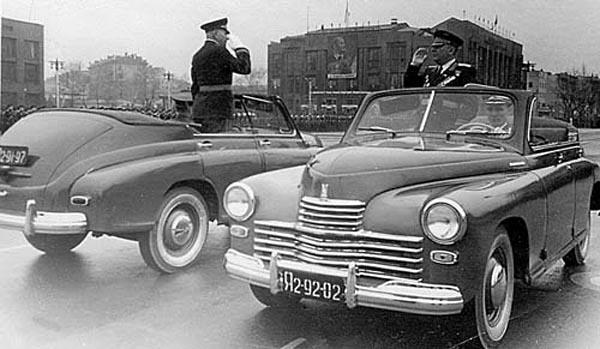
However, partial changes have occurred body - has been increased cabin height. The military and party officials, ezdivshie on the first "victory", complained that abut the ceiling with their cap and hats.
Production of the upgraded "Wins" resumed in November 1949. Before that, at the disposal of GAZ handed former aircraft factory premises, which housed and 9 new pipelines. The case has gone, the production of machines is now in the thousands.
In addition to the basic model, the factory started the production of several of its modifications, which were in their own original, but less successful.

The last major domestic avtodizaynerov luck and time, and the title coincided with the biggest achievement of Russian armed forces.
In the history of domestic car "Victory" it became a symbol of the postwar era - when the country was reborn from the ashes and is committed to new frontiers, surely becoming a superpower. It was a time of great hope and remarkable achievements that are etched in people's minds with the silhouette of the popular car. The concept of development of the automotive industry of the USSR in the 30s was determined not only economic but also political considerations. On the one hand, the emphasis on rapid replenishment fleet of trucks, military vehicles and public transport. Last allows you to quickly solve the problem of traffic is rapidly growing urban populations.
On the other hand, contrary to the well-known adage, cars were for the majority of citizens is not so much a means of transportation as a luxury. Because there were not enough of them and they cost is not cheap, their owners watched with envy. The party leadership has been a view that the private passenger cars - is "regurgitation of the bourgeoisie" and the Soviet people will be enough buses and taxis. Defeating the resistance of conservative Marxists could a simple argument: the mass production of fairly inexpensive car will make it as accessible technical means, as well as home appliances. It is only necessary to create for this industrial base.
This possibility emerged in the late 30s. At the Gorky Automobile Plant started the development of two models of small cars that were to be the basis for the future of the Soviet "people's car". And as the car of the middle class was offered to replace GAZ-M1 ("Emku") to something more contemporary and release tens of thousands each year. Already thinking about where to build new plant as the Great Patriotic War broke out. All resources, of course, were thrown on the defensive - and gas is fully engaged in the production of military trucks, armored cars, light tanks, commander of cars. However, the design of civilian vehicles did not stop even during those difficult years. It was then developed "Victory».

February 3, 1943 the country celebrated the end of the Battle of Stalingrad. In Moscow, opened the meeting Narkomsredmasha dedicated to the creation of the Soviet civilian cars. The decision to renew the old and start new development was met with great enthusiasm, they give people the hope that soon there will come a peaceful life.
However, the summer of 1943, the process was suddenly interrupted: the German long-range aviation began intensive bombing of Soviet enterprises. Heavily damaged and GAZ - according to experts, the restoration required a year, and only thanks to the dedicated work of clock his men failed to start in a month.
The project of the new car of the middle class joined the team under the leadership of Andrew Liphart Automobile (1898-1980). His deputy, Anatoly Krieger (1910-1984) was engaged in chassis and body design and construction - Alexander Kirillov, Yury Sorochkin, as well as the famous painter Benjamin Samoilov.

Initially, the new car was given the working title of the GAZ-25 "Motherland"; and it was the first time that the Soviet passenger car got its own official name. The authors probably thought it would be patriotic. However, they have lost sight of one small detail that, as popular myth, he immediately noticed Joseph Stalin (1878-1953). "Father of nations", he heard the name of the new machine, ironically remarked, and at what price will be sold as "Motherland"? Designers took the hint and immediately changed the name of his brainchild, "christened" his most popular word in 1945 - "Victory". Through subtle sense of humor did not become the leader of the car of the future character of "dissident" jokes, and was named to symbolize the new era of Russian history - which he triumphantly entered gleaming chrome hood.
The car almost from scratch was established during the year - its first model went into the courtyard car plant in November 1944. But at the time of war, even this long, long, because many designers create their models in a few months. Therefore, the fact that in today's automotive industry would be considered a record, then it was the norm. It should take into account the huge resource gap, which is compensated for resourcefulness. For example, wood (alder) details of the layout of the body permanently warped. Then they decided to be made of mahogany, it is unknown where razdobytogo in wartime. But these efforts were justified because it was the body of the main feature of "Victory».
Until that time, all Soviet cars had frame, on which rested the body. In the new project from the frame we have decided to refuse. This was due to the desire to reduce the weight and height of the car to win in speed. However, the first experience of creating a monocoque was unsuccessful, and several hundred "victory" of the first series suffered from the strain and crack the case, they broke down suspension. The errors were taken into account, moreover - to fix them with a solid margin of safety, so that these "Victory" won the reputation of "thick-skinned" domestic cars. That's why many of the "Victory", even after several decades of operation have not rusted to pieces, and in the collisions do not wrinkle as "tin" vases "Muscovites».

In addition, the design is constantly improved and modernized. It changed the look of the car: two-storey grille in the spring of 1947 gave way to a two-story, in which the lower chrome moldings did not come under the parking lights. Sami parking lights took a simplified form, without expansion in the middle of the round. It appeared on the front bumper beam between the canines. In the housing under the hood - hatch for access to the signals. Implemented Finally, the new solid wheels. An early version of the dashboard, the speedometer with a belt made on the model of the American Chevrolet, has undergone restyling - when you run into a series of simplified design and ennobled. Speedometer decided to establish a familiar, round shape - there was a place for the possible installation of the radio. Headbands headlights chromed steel, which gave clearance completeness front of the machine.
April 28, 1947 showed the Kremlin leaders no longer experienced and serial sample - reported about the start of mass production.
But one thing - Having reported, and the other - to make cars. More or less established cliches, but steelmakers have not been able to supply the required width of the rolled sheet. Yes, and the metal that was available - was beneath criticism. So, in July 1948 metal "Zaporizhstal" for stamping body parts Victory did marriage to 62%! The way out half-measures: at some point, even the metal imported from Belgium, but more often simply taken the appropriate sheets of Zaporozhye rolled, welded them together, and only then sent to the stamping. As it has become a tradition since the pre-production samples to correct surface defects that occur when using such technology to weld seams and dents solder. Though lead-tin solder for one car took 15-20 kg, plus the rest of the deviations from the technology, all this gave weight gain of 200 kg.

The rush when you run into a series of the best post-war car brought its usual results. Two years later, in October 1948, after the release of 1700 (according to other sources - 600) car, the car at the direction of the main Communist Stalin was discontinued, and all already released Victory (according to some reports) have been returned to the factory for refinement.
The fact that most of the cars produced fell into Soviet institutions to fairly high-ranking officials, who first used the ZIS-101. This category of employees should be provided with class cars ZIS-110, replace the "101st", but producing them is many times smaller than required, therefore a number of "senior officials" had to be transplanted to win. He also did not like the new strongly: crowded, not the speaker, and here and workmanship. In general, the complaints have gone, including the top. All of this boomerang of the plant and the person responsible for the quality, - the chief designer. The situation was paradoxical: the one who opposed the hasty start of the machine in a series, was Lipgart, he did not listen, and then he also had to answer for, against which he fought so fiercely ...
One way or another, but the experience of operation of the first batch of cars has been accounted for, and the plant began to bring the car to the design parameters. It is interesting that during the operation revealed not only weaknesses, but it was noted, and a lot of positive. For example, on any of the machines has never been any case damage the crankcase, despite the fact that the machines operated on rough roads.

But the flaws were in abundance: the engine detonated, the car is difficult to withstand protracted climbs. Rear Axle noisy. Pothole shook the helm. Door handles were broken. Windscreens burst and glass doors rattled. The interior penetrate dust, rainwater, and the wind was blowing. When starting clutch has constant jerks, revealed the ineffectiveness of the muffler and the parking brake. In addition, quickly boarded the rear suspension, the body turned out to be unequal strength. The car is badly dispersed, I expended a lot of fuel. The paint is quickly lost luster, swells and rebounds. There were no heater and windshield heater, insecure working windows. And the most insulting, especially for officials and military - low ceiling did not allow even a person of average height to sit in a hat or cap, not to mention the monumental hats commanders.
The poor quality of vehicles victory Loskutov released from the post of director of the gas. Waited for the punishment and Liphart. But Andrew A. At the time, escaped with only a reprimand - it took defense minister of the automotive industry Akopov. The fact that the designers of GAZ started work on a new car models GAZ-12, went first manufacturing prototypes GAZ-69, and the experience Liphart here was sorely needed.
Once on the winning effort body, introduced for the rear springs sheets parabolic cross-section, improved muffler, used heater and sealing body, upgraded carburetor, increased to 4, 7 to 5, 125 axle ratio and changed the gear ratios in the box "for children disease "largely outdated.
And at the request of carriers hats removed and tormenting their problem: just cut the plump seat cushion 5 cm in height. Yes, because in the end and left on the entire pipeline - here and material savings, and tall people well.
As a result of this work has been refined and put into production of 346 parts, introduced more than 2,000 new instruments. Is focusing on high-performance equipment and tooling, allow to adjust flow-mass production cars. All technical documentation to clarify and re-released. Redesigned stamps, minimizing the interface in the assembly body stampings. And this is a lot of work, because of all for making the Victory applied 199,457 stamps, tools and instruments!

The whole body "Victory" represented an improved version of the type «fastback», which in the 30's - early 40's have used German and Italian avtodizaynery. But he was executed in a smooth, rounded and streamlined lines, and its hood was not archaic "appendix" as its western counterparts. His second feature lies precisely in the fact that "victory" was the world's first passenger car without running boards and protruding wings. The fact that the West has become the norms of automotive design in the 50s and is still practiced in the Soviet Union did in 1943. That is why the "Victory" say that it is the only domestic car that has not been "pinched" with foreign models. On the contrary, the West copied the design of the "Victory", as, for example, the body of a British car «Standard Vanguard» 1947 looks very similar to the GAZ-M-20.
In the Soviet automotive form of "Victory" is no longer repeated, so it remains unique. On issued then ZIS-110 and GAZ-12 ZIM has not been such smooth lines, aerodynamic spoiled serving rudimentnymi and aft wings. The "Victory" is the luggage compartment, are made for the spare wheel, managed to squeeze so as not to disturb the smooth bevel, passing aft roof.
From predecessors "Victory" and featured a great many electrical appliances and machinery, previously unseen in civilian cars. Thus, the body appeared electrolamp direction indicators and brake lights that allow drivers no longer pop out of windows waving hands. Wiper blades on the front glasses got electric running even with the engine off. And inside the oven has been installed, make a winter trip a pleasure, not a test of the body's resistance to frost.

For the new car of the middle class and the corresponding required engine. In "Victory" First set the six-cylinder engine GAZ-11, well mastered the Gorky Automobile Plant during the war - he was mounted on armored vehicles and commanding GAZ-11-73 (a more powerful version of "Emka"). Powerful enough (76 hp with the ability to boost) and reliable, GAZ-11, then worked under the hoods of trucks GAZ-51, GAZ-12 Limousine ZIM, PAZ, and produced until 1992. With him "Victory" have long been the most Soviet fleet cars, but ... six-cylinder engine "hacked" Comrade Stalin personally, which is traditionally the bride brought new models. Not out of spite, but for reasons of economy. In the context of post-war devastation gasoline was expensive. Therefore, Stalin approved the project "Victory" with a less voracious four-cylinder engine producing 52 horsepower, which was used for another GAZ-A. Later, he was released a small batch of six-cylinder "victory" for the KGB garage (model GAZ-20-D), as well as sports modification accelerates to 190 km / h.

August 26th, 1945 in the decree of the State Defense Committee, "On the reconstruction and development of the automotive industry" was, among other things, recommended to start production of a new car of the middle class in the summer of 1946. Having received the serial GAZ M-20 "Victory" started off the assembly line.
But haste has led to numerous defects. And as among the first owners of "Victory" were generals and party officials, their complaints quickly reach the Kremlin. Therefore, in October 1948 at the direction of the Political Bureau of the release of the GAZ-M-20 was discontinued until all weaknesses. And issued before this car was returned to the factory. However, not all 10 "Victory" were taken at the Semipalatinsk test site, where they experienced the destructive power of the first Soviet atomic bomb. No less power sizzling anger hit makers of "Victory": the director was removed gas, and Andrew Liphart "took aim" and a few years later was accused of "cosmopolitanism».
Further development of the car was significant, among other things, an attempt was made to change and shape the body. For that fought the Soviet authority avtodizayner Dolmatovsky Yuri (brother of the poet Eugene Dolmatovski), which pointed to the lack of two large "Victory": a small amount of luggage, and a tiny rear view window. He proposed to fix this change the aft, the rejection of the style «fastback» trёhobemnogo and the creation of a body with a large protruding luggage compartment. But to change the form of the "Victory" did not. But Dolmatovski proposal took into account the development of the GAZ-12 ZIM, was created as an enlarged version of "Victory", and then the GAZ-21.

However, partial changes have occurred body - has been increased cabin height. The military and party officials, ezdivshie on the first "victory", complained that abut the ceiling with their cap and hats.
Production of the upgraded "Wins" resumed in November 1949. Before that, at the disposal of GAZ handed former aircraft factory premises, which housed and 9 new pipelines. The case has gone, the production of machines is now in the thousands.
In addition to the basic model, the factory started the production of several of its modifications, which were in their own original, but less successful.
Tags
See also
They no longer exist
Tram accident in the Soviet Union (24 photos)
Minsk residents said, as he was the last great treasure found in the USSR
Why monuments?
Market Overview wearable devices with a brief historical note
Israeli sketches
Great post 2016. A calendar of food days
Historical photos of 1913

















